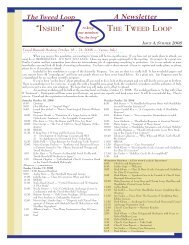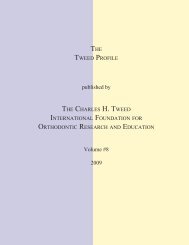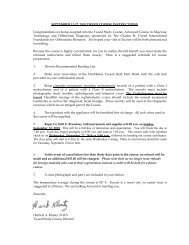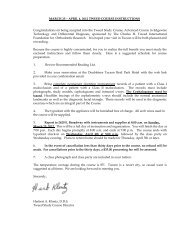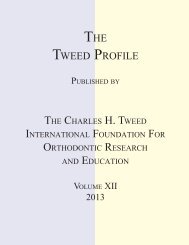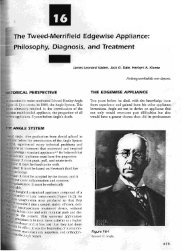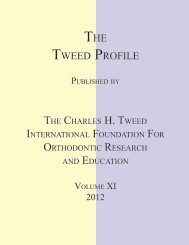© 2006 - The Charles H. Tweed International Foundation
© 2006 - The Charles H. Tweed International Foundation
© 2006 - The Charles H. Tweed International Foundation
You also want an ePaper? Increase the reach of your titles
YUMPU automatically turns print PDFs into web optimized ePapers that Google loves.
Recently, with the rapid development of implantology, the orthodontic field has moved to incorporate suchtechnology into its existing treatment (Fig. 1). <strong>The</strong>re are several kinds of skeletal anchorage systems,1) Prosthetic implant2) Orthodontic implant3) Onplant4) Miniplate5) MiniscrewII. What is a microimplant (MI)?A microimplant is a kind of mini-screw made for orthodontic use. It has a special button-like head with a small holethat accepts ligatures and elastomers. It has a hexagonal shaft for the screwdriver which is used to install it and asmooth shaft for soft tissue mucosa or gingiva as well as the thread part that is implanted into the bone. (Fig.2) OurMIs are 1.2-1.7mm in diameter, so we use the term micro instead of mini. When a foreign object is retained in thehuman body for more than one month, it can be classified in the implant category, so we named it microimplantinstead of miniscrew. We have developed a new miniscrew which is designed for orthodontic use. It is namedthe Absoanchor Microimplant. <strong>The</strong>re are many different diameters, lengths and head shapes of MI for differentorthodontic purposes.III. Why do we use MI as orthodontic anchorage?First, It is very simple to install and remove. Every orthodontist can do it in his or her office in a few minutes.Second, you can install a MI at almost any site you want. <strong>The</strong>re is only minimal anatomic limitation because it is verysmall.Third, immediately after installation, force can be applied with a Niti coil spring, power chain, rubber band or elasticthread etc.Fourth, it is very cheap when compared to dental implants or mini plates.Fifth, MIs provide absolute anchorage. We will show two patients who were treated by using microimplant anchoragein the maxilla. Superimposition of pretreatment and posttreatment cephalograms showed tremendous retraction of themaxillary anterior teeth, a change of ANB, and slight molar distal movement rather than anchorage loss as is seen inconventional treatment. That means MI provides absolute anchorage for these patients (Fig.3).Sixth, we adopt SWA and sliding mechanics using MIA in order to simplify treatment protocols. Depending on theparticular case and the doctor’s preferred technique, the position of the MI, the height of hook, the wire size andcompensating curve, and type of force can be determined.Seventh, it provides a treatment alternative for previously unsolvable or difficult orthodontic problems. Some patientswho were treated with MI will be shown. <strong>The</strong>se patients were very difficult to treat before MI.Molar uprighting without extrusion is one of the challenging movements in adults. However, a microimplant in theretromolar area provides a stable way to upright and intrude molars (Fig.4).Intrusion of an extruded molar on the opposite side of an edentulous area is one of the difficult problems inorthodontic treatment. But now, without any unfavorable reaction of other teeth, one can easily intrude molars usingMI. On the other hand, when intrusion of lower molars for prosthetic space like this example is needed, two MI canbe installed at the buccal and lingual areas and a force applied. Afterwards there is enough space (Fig. 5A,B.).Asymmetric arch expansion or constriction cannot be obtained by using conventional methods because the number of37



